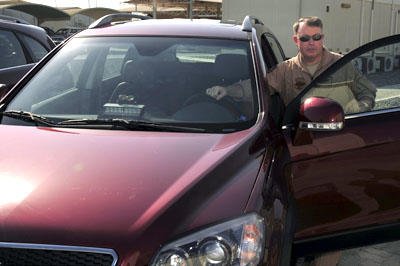When retired Capt. Pete Hegseth returned home from Iraq in 2006, he did not leave behind his combat driving instincts. As an infantry platoon leader, he had become an alert driver on Iraqi highways and city streets.
"You don't know what heightened senses are until you understand that every trash bag and mound could be an explosive. You're completely focused on the task," says Hegseth, a veteran who served in Afghanistan, Iraq and Guantanamo Bay, and is the CEO of Concerned Veterans for America. "For a while after you come back, that switch is still on."
Hegspeth's personal experience may illustrate what new research by USAA has revealed about the effect of deployment on driving behavior.
According to a recent survey by USAA, nine out of 10 service members say it's dangerous to text and drive. About a third do it anyway. But there's one group that is bucking this trend by a wide margin.
Service members who have been deployed text less while driving than those who have never been deployed (39 to 53 percent), according to the survey.
And for service members who have been home for six months or less, the difference is even more striking: Just 34 percent of those surveyed say they text while driving.
Karen Sprattler, who has studied distracted driving for the Governors Highway Safety Association, says returning soldiers' heightened focus on the road is likely behind the results.
"Driving habits of previously deployed service members were likely shaped by hazardous driving experiences during their deployment, where total focus on and attention to the driving task could mean the difference between life and death," Sprattler says. "Now home, while the driving environment may be different, these lessons learned still apply," she adds.
The GHSA's research shows that distractions are a likely factor in 15 to 25 percent of all crashes, and texting is even more risky than talking on a phone.
Last year, USAA joined forces with AT&T in support of the It Can Wait® movement, which aims to make texting while driving as socially unacceptable as driving while drunk.
Texting while driving remains a serious problem in both civilian and military populations, but the lower texting rates among recently deployed service members have been hailed by some experts as an encouraging trend.
"Given the risks of texting while driving, this is good news," says David Strayer, a psychology professor at the University of Utah who has studied distracted driving for more than a decade.
"What is causing the difference in behavior is difficult to say," he notes. "It could be that there is something about the selection process for who deploys and who doesn't that influences the attitudes and behaviors of texting and driving.
"Alternatively, the experience of deploying may change behavior. I've seen other reports showing a higher crash risk for soldiers returning from deployment, and this may be a byproduct of the military working to address that issue," he says.
While a range of factors may be involved in distracted driving, one thing is clear: Texting is increasingly ubiquitous.
According to the Ericsson Mobility Report from November 2013 from telecommunications company Ericsson®, the smartphone market share in North America will hit 90 percent by 2015, and a separate study by marketing firm Experian® found that the average U.S. smartphone owner — ages 18 to 24 — sends 2,022 texts per month.
"Texting is very compelling," says Gary Small, a professor of psychiatry and biobehavioral sciences at UCLA. "We're social animals, and we like to be connected to others, so it's easy to get drawn in. It becomes a habit that impairs our judgment when we drive."
"The best solution would be some kind of device that deactivates texting in vehicles," he adds. "Until that happens, it's likely that the number of texting-related accidents will continue to go up. So far, legislation hasn't helped the problem. The threat of getting a ticket only gets people to hold their phone lower so they don't get caught, which is probably even more dangerous."
The new USAA survey is based on telephone interviews with 904 active-duty military personnel across all five service branches between June 12 and July 14, 2013. The military services were not involved in commissioning this survey, but the results of the survey have been shared with the branches' military safety centers.
The survey found that officers are more likely than enlisted personnel to read or send text messages while driving (51 to 41 percent), and service members ages 21 to 24 are the most likely to do so.
Joel Camanaro, the assistant vice president for USAA's Property and Casualty Insurance Group's Auto Innovation and Development Team, says USAA has helped increase awareness of the dangers of texting while driving.
"We can certainly dig in to this a little further, but I think the findings are less about the fact that the service member was deployed and more about texting and driving being a habit," Camanaro says. "When you are deployed, you may be forced to break the habit."
Indeed, of the service members who admitted to texting while driving regularly, 38 percent said they did so out of habit.
Charlie Klauer, lead author of a recent study by the Virginia Tech Transportation Institute, also believes the survey results reveal that service members form specific driving habits during deployment.
"I've seen research indicating that [combat veterans] also have less of a tendency to wear seat belts, which makes sense if you've been in an active war zone and you have to be able to jump out of your car," Klauer says.
"There's a proliferation of smartphones, and it's just getting worse," she adds. "With a smartphone, you've got to look — there's no choice. In terms of a truly hands-free system, which is clearly the wave of the future, I'm unsure we've reached that point."
It is unclear how long the effects of a recent deployment last. Overall, the survey found that 43 percent of active-duty military members text while driving, a rate similar to that reported by teen drivers and other civilian commuters in surveys commissioned by AT&T in 2012 and 2013.
"As time passes and the service members become accustomed to noncombat situations, their behavior would tend to be the same as civilians," says Judith Broder, founder of The Soldiers Project, which offers free psychological counseling to veterans and their families.
"It would be interesting to know if those who text and believe it is dangerous are combat veterans," Broder says. "If that is the case, we know that returning service members often engage in risk-taking, including driving dangerously, so it would be compatible with that," she said.
Kristel Vear, a retired Army sergeant who served in Afghanistan and Iraq and currently lives in Sherman Oaks, Calif., thinks habits do change over time.
"When you first come back from deployment, your phone isn't a priority to you because it's not part of your daily routine yet," Vear says. "You are still very alert of your surroundings. A lot of the time it's like, 'Where's my weapon?' Then you have to remember that you're back stateside."
That's worn off now, but Vear says she avoids risk-taking.
The bottom line?
"It's becoming ubiquitous that we bring cellphones into the vehicle with us," Sprattler says. "Distracted driving is not a new thing. It's just that more and more of our distractions are becoming technology-based."
The trademarks, logos and names of other companies, products and services are the property of their respective owners.
No Department of Defense or government agency endorsement.










